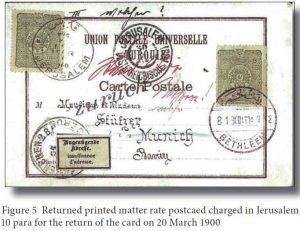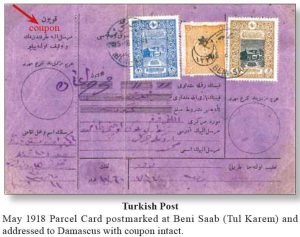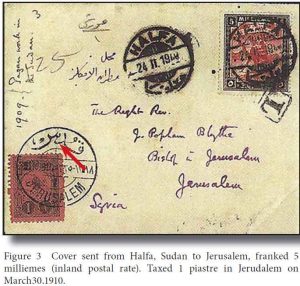FORERUNNERS
Turkish Post Offices
****Background****
Go to Bottom
The earliest recorded usage of ordinary stamps as postage due is shown in Figure 5. The postcard had been mailed from Bethlehem on January 8, 1900 and franked 10 para only – the printed matter rate. Having been insufficiently addressed it was returned from Munich, Germany via the Austrian Post Office (Jerusalem) to the Ottoman Post Office in Jerusalem. There, a 10 para stamp was affixed on March 30. This was the fee for the return of printed matter mail.
Taxed Mail of the Ottoman Period – Part 1. The Israel Philatelist, April 2012, p. 19.
May 1918 Parcel Card postmarked at Beni Saab (Tul Karem) and addressed to Damascus with coupon intact.
Parcel Post & Parcel Card Usage Part 2 – Holy Land 1882 – 1954. The Israel Philatelist, Winter 2016, p. 16.
Letter from Jerusalem to Jaffa 1870’s
Description
Date
Postage
Turkey 1875 issue 2×1 Piaster orange (Michel 21)
Markings
Place of Origin
Place of destination
Object Type
The Alexander Collection
http://www.alexandercollection.org/collectionitem.aspx#collection=287&item=690812873&startitem=3
Figure 3 shows the front of a under-franked cover mailed from Halfa, Sudan to Jerusalem (5 milliemes postage instead of 1 piastre) on February 24, 1910. It bears an Egyptian– type postage due “T” mark and a manuscript notation “25” (centimes) in the upper left corner. Accordingly, it was charged in Jerusalem 1 piastre (2.5 x 0.4 = 1 Egyptian piastre of almost equal value to 1 Turkish piastre). A 1 piastre postage due stamp of the 1908 issue was used to collect the charge.
Taxed Mail of the Ottoman Period – Part 1. The Israel Philatelist, April 2012, p. 19.
The newspaper dated 14th January 1901 shown in Figure 3, was sent from the OLD CITY, franked with the newspaper rate of 5 para by an overprinted Turkish stamp. The stamp is canceled by the postmark “QUART ISRAELITE” (Steichele 33/02, Collins PM 3) of the branch post office in the Jewish Quarter in the Old City of Jerusalem.
Both Steichele and Collins note the 11.2.1901 as the first date of use of this postmark. However the “Habazeleth” newspaper shown in Figure 3 appeared on the 14th of January 1901, 28 days earlier.
According to the Internet site of The National University Library the dates on which the “Habazeleth” newspaper appeared during January 1901 were: 7, 14, 25. This could mean that the newspaper was posted between the 14th and the 25th of January 1901 and that the postmark canceling the stamp on the newspaper is of the earliest date known so far by at least 21 days before the date mentioned by Steichele and by Collins. This assumption is however, non conclusive as it could have happened that the original recipient of the newspaper has sent it to a third party at a later date. A definite conclusion could perhaps be reached from relevant information from the Turkish PTT Records. Those are not available to the author or to the editor.
In addition this copy of the “Habazeleth” is the only one known so far that was dispatched from the Jewish Quarter of the Old City in Jerusalem.
The Rare Newspaper Mail Stamp. The Israel Philatelist, April 2013, p.51.
Background
The postage stamps and postal history of Palestine emerges from its geographic location as a crossroads amidst the empires of the ancient Near East, the Levant and the Middle East.
During Ottoman rule in Palestine , stamps issued by the Ottoman authorities were valid in Palestine. In 1834, after improving its transport and communication systems, the Ottomans established a new imperial postal system. Ottoman post offices operated in almost every large city in Palestine, including Acre, Haifa, Safed , Tiberias , Nablus , Jerusalem , Jaffa , and Gaza.
Thanks to the work of philatelic scholars, it is possible to reconstruct a reliable list of Ottoman post offices in Palestine.
The Imperial edict of 12 Ramasan 1256 (14 October 1840) led to substantial improvements in the Ottoman postal system and a web of prescribed and regular despatch rider (tatar) routes was instituted. Beginning in 1841, the Beirut-route was extended to serve Palestine, going from Beirut via Damascus and Acre to Jerusalem.
Postal services were organized at the local level by the provincial governors and these leases (posta mültesimi) came up for auction annually in the month of March. It is reported that in 1846 Italian businessmen Santelli and Micciarelli became leaseholders and ran a service from Jerusalem to Ramle , Jaffa, Sûr, and Saida. By 1852, a weekly service operated from Saida via Sûr, Acre (connection to Beirut), Haifa, and Jaffa to Jerusalem, also serving Nablus beginning in 1856. That same year, two new routes came into operation: Jerusalem–Hebron –Gaza, and Tiberias–Nazareth–Shefa-‘Amr–Acre. In 1867, the Jerusalem—Jaffa route operated twice a week, and beginning in 1884, the Nablus—Jaffa route received daily despatches.
In the last century of Ottoman rule , in addition to the Ottoman state postal service, up to six foreign powers were also allowed to operate postal services on Ottoman territory, with such rights originating in the Ottoman capitulations and other bilateral treaties. At the beginning of the First World War, the specific postal rights enjoyed by these foreign powers throughout the empire were revoked by the Ottoman authorities. Beginning in 1900 through until the war’s end, Ottoman citizens, including those in Palestine, were forbidden to use the services of the foreign post offices.
In A Handbook for Travellers in Syria and Palestine (1858), Josias Leslie Porter describes the system operated by the Ottoman authorities at the time: “The Post Office in Syria is yet in its infancy. There are weekly mails between Jerusalem and Beyrout , performing the distance in about four days; there is a bi-weekly post between Damascus and Beyrout, taking about 22 hours in fine weather, but occasionally a fortnight in winter; and there is a weekly Tartar from Damascus to Hums , Hamâh, Aleppo and Constantinople —making the whole distance in 12 days. He leaves on Wednesday. All letters by these routes must be addressed in Arabic or Turkish, and prepaid. The Turkish posts have no connection with those of any other country; and consequently letters for foreign countries must be sent either through the consuls, or the post agents of those countries, resident at the seaports.”
OTTOMAN POST OFFICES
Main article: List of Ottoman post offices in Palestine Initially all the postal facilities had the status of relay stations, and letters received their postmarks only at the Beirut post office, with one exception: markings Djebel Lubnan are believed to have been applied at the relay station Staura (Lebanon ). In the 1860s, most relay stations were promoted to the status of branch post offices and received postmarks, initially only negative seals, of their own. The postmarks of an office’s postal section usually contained the words posta shubesi , as opposed to telegraf hanei for the telegraph section. In 1860, ten postal facilities operated in Palestine, rising to 20 in 1900 and 32 in 1917. Travelling post offices existed on three routes: Jaffa–Jerusalem, Damascus–Haifa, and Messudshi—Nablus. No TPO postmarks are known for other railway lines.
OTTOMAN POSTAL RATES (1840–1918)
Main article: List of Ottoman postal rates in Palestine The Imperial edict of 12 Ramasan 1256 and later ordinances made the distinction between three types of mail items: ordinary letters, registered letters (markings te’ahudd olunmoshdur), and official letters (markings tahirat-I mühümme ). Fees were calculated by the type of mail, the weight, and the distance (measured in hours): in 1840, an ordinary letter, weighing less than 10g, had a cost per hour of 1 para. Special fees applied to samples, insured mail, special delivery, and printed matters, etc. These postal rates changed frequently, and new services were added over the years. Upon joining the Universal Postal Union on 1 July 1875, Ottoman overseas rates conformed to UPU rules.

![turkish-tower[1]](https://israelstamps.com/wp-content/uploads/2017/08/turkish-tower1-e1502840407832-174x300.jpg)




